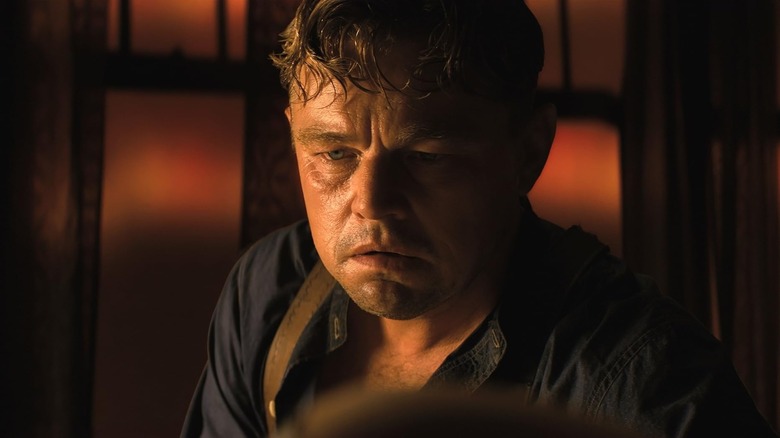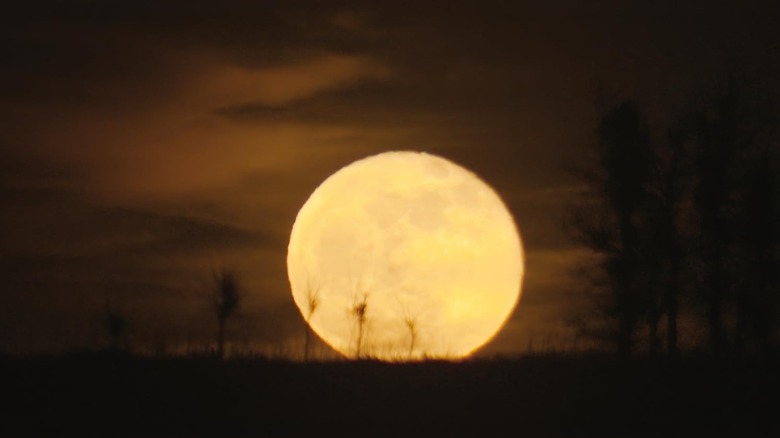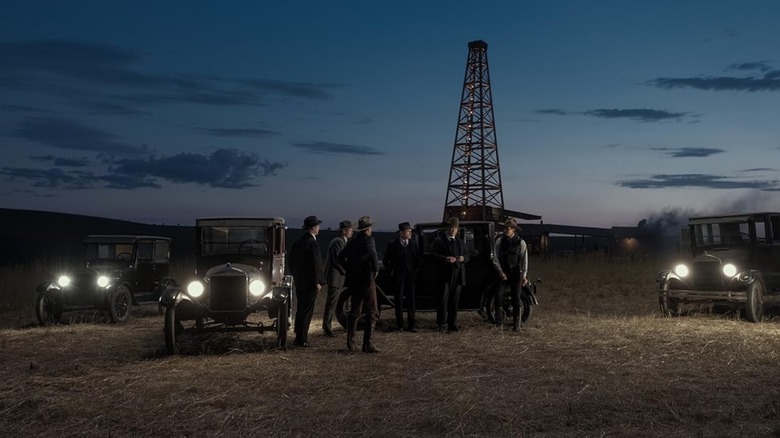How Killers Of The Flower Moon Makes Oklahoma's Beautiful Landscapes Feel Sinister
Making a Western remains something of a rite of passage for New Hollywood directors. John Carpenter spent much of his career espousing the classic oaters directed by titans like John Ford and Howard Hawks — a passion that would manifest itself in the central siege in "Assault on Precinct 13." Steven Spielberg has similarly talked on and off over the years about putting on a pair of spurs, although he has yet to commit on that front.
Martin Scorsese, on the other hand, has finally gone and made his own cowboy picture with "Killers of the Flower Moon," a big-screen adaptation of David Grann's 2017 non-fiction book about the "Reign of Terror" that resulted in the murders of numerous members of the Osage Nation after oil was found on their reservation. At the same time, "Flower Moon" isn't your typical Western, at least not in the Hollywood tradition. Co-star Lily Gladstone has previously called it "a great American tragedy," telling Empire, "With natives and Westerns, we are so dehumanized that it just kind of feels like we're part of the landscape — instead of humans that are telling a story."
Although it corrects this by better humanizing and centering the Osage in a story that's ultimately about white greed (as told by Scorsese, that is), "Flower Moon" retains most of the Western's customary motifs. Besides the struggle between the law and lawlessness, that includes an emphasis on the untamed landscapes that echo this central conflict, in addition to setting the tone. Befitting its tale of murder and betrayal, "Flower Moon" makes its Oklahoma backdrop feel insidious and threatening, which is no easy task given just how beautiful that area is. In a press conference attended by /Film's Ethan Anderton, Scorsese offered some insight on how he went about doing that.
A New Yorker heads west
Having spent his career mostly directing films in New York or other urban settings, Scorsese was — to paraphrase Walter Sobchak from "The Big Lebowski" — out of his element filming "Flower Moon" on location. "I am a New Yorker, I grew up in the Lower East Side of New York. I'm very urban," he admitted. "I don't understand weather that much, or where the sun is when you're on a set. I was very surprised to learn that it set in the West. That's because I was driving down Sunset Boulevard one time about 30 years ago and I saw the sun setting. And I said, 'That's great. It's Sunset Boulevard. The sun sets in the West. Now I get it.'"
Let us all pause a moment to appreciate that truly adorable anecdote. Once he adjusted to being on a prairie, Scorsese set to work figuring out how best to frame it. The horizon was one thing (say it with me now: "When the horizon's in the middle, it's boring as s**t!"), but the more Marty took it in, the more he realized it could be made to look far from idyllic. Doubly so when lit the way it would have been in the 1920s when "Flower Moon" takes place:
"And so I said, 'Where do I put the camera at this point? How much of the sky? How much of the prairie? Should it be 1:85, or should it be 2:35? We got to go 2:35. I want to see more of this land.' And then I began to realize that the land itself could be sinister. In other words, if you're in a place like this and you don't see people from miles, you could do anything. Particularly, it turns out, 100 years ago."
An 'easygoing genocide'
Being set in the 1920s, "Flower Moon" doesn't have the trappings of a stereotypical Western. Its world is closer to that of "The Great Gatsby," with people driving around in swanky attire and shiny new automobiles. But just as wealth, class, and privilege color how the law works in F. Scott Fitzgerald's Jazz Age tragedy, Scorsese realized justice could be easily bent to the will of the powerful white men invading the Osage's land in his film. "You have the law, but the law isn't working that way. The law, you can make the law work for you if you're smart enough," Scorsese noted. In that regard, the setting is as much a "wide-open territory" (as he referred to it) as that of a more prototypical Western.
This also makes it easier to cover up terrible acts of violence — something Scorsese sought to emphasize by juxtaposing the murders in the film with the surrounding open landscapes. We see this in one of the many horrifying scenes in "Flower Moon" when an Indigenous American character is deliberately encouraged to get drunk, unaware that a hired gun is waiting to take him into a car to the middle of nowhere and shoot him in the back of the head. This vile deed is captured in a wide shot, with the gunshot echoing and then vanishing into the silence of dusk. What might've otherwise been a moment of serenity is instead rendered terrible and disturbing.
"The place, as beautiful as it is, can shift to being very sinister," as Scorsese put it. "And what I wanted to capture, ultimately, was the very nature of the virus or the cancer that creates this sense of an easygoing genocide."
"Killers of the Flower Moon" opens in theaters on October 20, 2023.


